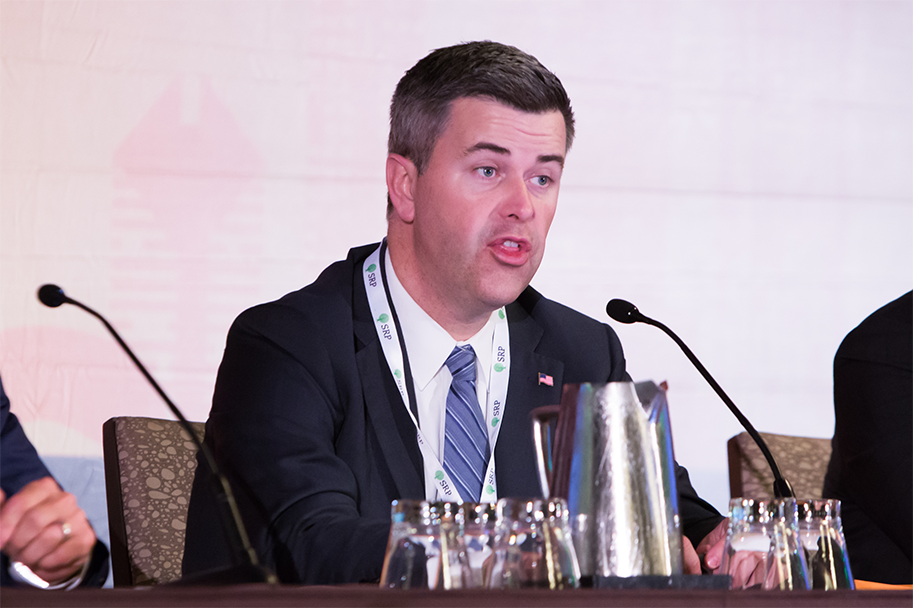Structured notes have been the most important vehicle for delivery-based payoffs for the last two decades but the revival of unit investment trusts (UITs) has introduced a degree of competition between the two wrappers, according to panellists at the New Product Development: Reflecting the Regulatory Environment and Innovation discussion during the 7th SRP Americas Conference on May 24 in Chicago. "Most of our clients nowadays are comfortable with this approach [UITs] as it is like fixed income. If you need to sell it, you ask for a bid. If you need to buy, you ask for an offer," said Daniel Yang (pictured), partner at Alaia Capital.
The structured notes market in the United States is at US$65bn, a figure that is dwarfed by fiduciary products such as mutual funds and exchange-traded funds (ETFs) which are growing and approaching US$20trn, according to Yang. "That speaks to the comfort level that most investors have with the fiduciary overlay where there is no uncertainty on price," said Yang. "The fiduciary overlay eliminates a lot of the silly gamesmanship in the market and clients feel comfortable knowing that what they get is advertised and that they don't have to be suspicious with the provider."
Tom Haines (pictured below), senior vice president, capital markets and index solutions at Annexus, pointed that at Annexus fiduciaries are regarded as advisers. "There should be some sort of fiduciary standard for advisers,"said Yang. "For example, when they sit there with their clients, they have to think about what are the type of financial products that they can use to navigate various situations."

The growth of the structured products market coincides with the growth of wealth in the country, according to Ken Kwalik, equity derivatives portfolio manager at Harvest Volatility Management. "We [Harvest Volatility Management] will be rolling out a suit of mutual funds which will pair the underlying with our overlay strategy," Kwalik said. "Up to now the big benefits of structuring a product has been that you can take the overlay and apply it to many different forms of based collateral, which ultimately affects the underlying allocation and investor's portfolio."
From 1982 to the middle of 2016, the world witnessed a strong bond bull market and therefore the concept of having a diversified stock bond portfolio seemed to make a lot of sense, according to Haines. "But instead we get negative interest rates, [and] the market needs to address various issues," said Haines. "I think we can all address them with our products in the structured space as well as in the index annuity and insurance industry."
Annexus is highly active in the retirement market as a provider of indexed annuities. "At the end of the day, we know that the retirees in the United States are unfunded and there remains the questions of how they are going to be able to live in their 90s with sufficient income as we know that Social Security won't be able to keep up with inflation and there is a risk that it will run out of funds eventually," Haines said. "We are trying to address those issues with our offering and that is where we are focused right now."
Many advisers are leaving the major wirehouses to become independent advisers, according to Haines. "They need solutions for their clients and they are acting as fiduciaries," said Haines."Advisers in the United States are dealing primarily with baby boomers and trying to help them think about lifetime income. What we have seen in the fixed annuity industry is legitimisation of the products. It really becomes a different product for that segment of clients as opposed to someone who is younger who wants to take a little more spectrum of views. Structured notes are definitely there."
According to Kwalik most structured products in the United States are born out of the need for yield. "With rates being low following the Global financial crisis, this [the need for yield] has remained the common theme among the private wealth community," Kwalik said. "One of the strongest signals out there is that the banks have less of an ability to wind into the short vault trade and that represented unique opportunity for the private wealth clients."
Tthe presence of advisers in the market is essentialbut the structured products market in the US is "unapproachable because it is expensive for high net worth investors, and complicated and nichefor retail investors, according to Yang. .
This prompted Alaia Capital to eliminate the term 'structured' from most of its educational and marketing materials on the basis that it found it to be "a little bit intimidating and having its own connotations", according to Yang. "The last thing we have done is elimination of the payoff diagrams which we found most people who don't have a broad understanding of in derivatives find a bit confusing," Yang said. "Over the last ten years, the industry has done a really good job of addressing a lot of these issues by rising platforms, by focusing on education and even by exploring some type of unified nomenclature for the names. However, we have a lot more things to do and this will require us to think out of the box."
Nowadays, with the whole adoption and growth of smart beta and quantitative strategies, the industry is building an even better accumulation engine, according to Haines. "We have been able to utilize smart beta strategies in a powerful way with strong brands, clear provision on how the strategy works and delivering returns," he said. "Advisers are now able to sit down with their clients and have a more long-term discussion about retirement planning and utilizing a fixed income annuity in the product. [There is]nothing wrong with these productsas they have liquidity, short-term time frames and higher net worth abilities, according to Haines.
However, Yang firmly believes that unit investment trusts (UITs) will be needed to complement the structured investments landscape in the years to come. "It is important to know that they are not going to replace notes but rather are going to coexist with them if we are all collectively successful in growing this business," he said. Using the Rule of 72 according to which 72 divided by the growth rate gets you the number of years that takes for something to double, Yang concluded that if the assumed growth rate is ten, then the structured notes market, now at US$65bn in the United States is going to be at US$130bn in about seven years.
From an issuer perspective, however, there is not enough appetite to issue that much debt, according to Yang. "If you are a large issuer right now, the idea of issuing twice the amount of notional on notes in a couple of years may seem extremely difficult," he said, adding thyat UITs are not going to replace notes but are a good complement. "We will all know that notes have graduated to more complex payoffs. Thus, for me the question is not can UITs complement structured notes but when will this happen."

Related stories:
"More than 50% of our clients are buying structured notes for the first time on our platform", SRP Americas
SRP Americas 2018 Personality of the Year (Part 1): Anna Pinedo
SRP Americas 2018 Personality of the Year (Part 2): Anna Pinedo